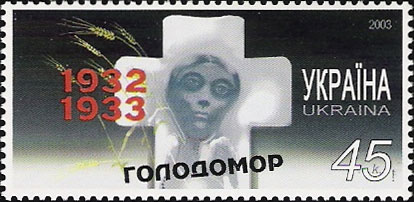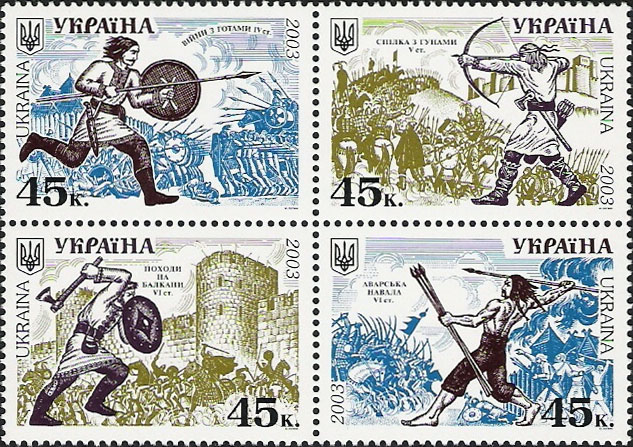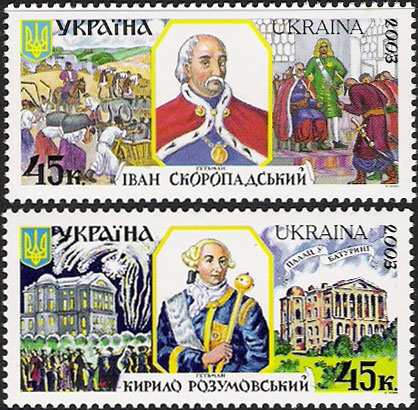Ukraine-Estonia Joint Issue Wins Top Prize for 2004 Narbut Prize
 An unusual joint issue showing the medieval "Route From the Varangians to the Greeks" won the Heorhiy Narbut Prize as the best-designed Ukrainian stamp of 2003. The two stamps, vertically se-tenant with an interspaced label, depict the eastern European trading route that once ran between two countries that last year cooperated to produce the joint issue - Estonia and Ukraine.
An unusual joint issue showing the medieval "Route From the Varangians to the Greeks" won the Heorhiy Narbut Prize as the best-designed Ukrainian stamp of 2003. The two stamps, vertically se-tenant with an interspaced label, depict the eastern European trading route that once ran between two countries that last year cooperated to produce the joint issue - Estonia and Ukraine.
The "Route," which began along the shores of the Baltic Sea, was used by the peoples better known to most as the Vikings (those of eastern Europe, however, are referred to as the Varangians). During a period of several hundred years (9th to 11th centuries) they traveled up and down the riverine arteries of the eastern Europe carrying furs, timber, grain, amber, honey, wax, and slaves southward in exchange for silver, silks, spices, and other riches from the final destination of the "Route," fabled Constantinople (capital of the "Greeks", i.e., the Byzantine Empire).
About the Joint Issue
The Ukrainian issue turned out to be the most elaborate prepared by Ukraine Post last year: the stamps were printed in a special pane format as well as in a special four-page presentation booklet.
The se-tenant combination itself illustrates the route that was followed: beginning near the suburbs of modem-day Stockholm, passing through the Baltic Sea and the Gulf of Finland, then through rivers passing into or out of Lakes Ladoga and Ilmen to the great Dnieper (Dnipro) River, which runs to the Black Sea and then ultimately to Byzantium.
The upper (80 sotykiv) stamp represents the area of departure for the "Route." On the left, overlaying the map background on the stamp design, is a gold coin of the Danish King Svend Estridsen (1047-1075); on the right is an English miniature "Landing of the Scandinavian Seamen" dating to the 12th century. This design was prepared by Jaan Saar of Estonia.
The map on the lower stamp (also 80 sotykiv) shows a simplified view of Constantinople, the final goal of the "Route." The silver coin on the left is that of Grand Prince Volodymyr of Rus (medieval Ukraine), who ruled from 980 to 1015. The ship on the right is an ancient Slav military craft copied from a manuscript of the Middle Ages. This design was the work of Oksana Ternavska of Ukraine. Both artists will receive equal shares of the $250 Narbut Prize honorarium. The 2004 favorite broke a trend that had seen a souvenir sheet emerge as the winner for six years in a row.
Other Top Vote Getters
 A record number of votes were received for the Narbut Prize balloting this year. The "Route" stamps were selected by almost 16% of the participants in the voting. Second place went to the Holodomor stamp with just under 10%. The Holodomor is the Ukrainian word used to describe the terror-famine imposed on the Ukrainian populace in 1932-33 by Soviet authorities seeking to destroy Ukrainian nationalism. An estimated 7 to 10 million people were condemned to a slow execution in this one of the most ghastly genocides of the 20th century.
A record number of votes were received for the Narbut Prize balloting this year. The "Route" stamps were selected by almost 16% of the participants in the voting. Second place went to the Holodomor stamp with just under 10%. The Holodomor is the Ukrainian word used to describe the terror-famine imposed on the Ukrainian populace in 1932-33 by Soviet authorities seeking to destroy Ukrainian nationalism. An estimated 7 to 10 million people were condemned to a slow execution in this one of the most ghastly genocides of the 20th century.
Tied for second place was the History of the Ukrainian Army issue, which last year depicted warfare involving the ancient Slavs. The fourth place selection fell to the last stamps of the Hetmans of Ukraine series (9%), which began in 1995 and has honored several hetmans every year since). The hetmans were Cossack leaders of the 15th to the 18th centuries. Last year’s stamps honored Kyrylo Rozumovsky (r. 1750-64) and Ivan Skoropadsky (r. 1708-1722 ).
Falling to fifth place in the voting were the Ukrainian Folk Costumes stamps, which garnered 8% of the ballots. The Costumes series had come in first in 2003. 




